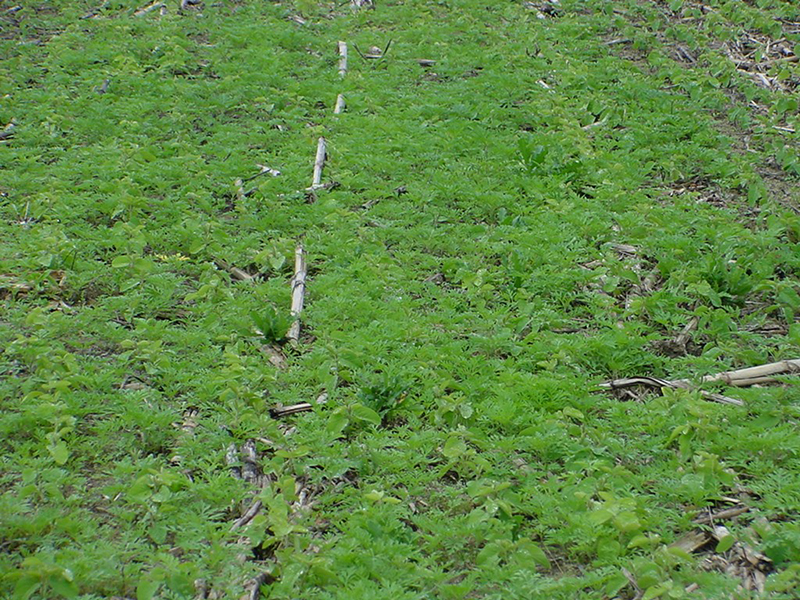ALS Resistant Common Ragweed
PICTURE OF THE WEEK | January 23, 2023
Bill Johnson, Professor of Weed Science, Botany and Plant Pathology, Purdue University
Marcelo Zimmer, Weed Science Program Specialist, Purdue University
To people who use herbicides, the term 'resistance' is not new. Like bacteria to antibiotics and insects to insecticides, plants can develop the ability to tolerate herbicide applications that at one time could control them. The process of developing resistance is based on natural selection. Variation in a plant's physiology or morphology can make it possible for the plant to survive a herbicide application. The plant that can survive the herbicide application is allowed to produce the next generation with the same ability to survive the application of that specific family of herbicides. Continued use of this herbicide or herbicides that are similar in their activity, will suppress the non-resistant (or sensitive) plants and allow the resistant plants to survive. This will build up a seed bank in the soil of the resistant plants waiting to emerge when the conditions are suitable. Common ragweed is no exception to this.
Common ragweed (Ambrosia artemisiifolia L.) is no stranger to Indiana's production fields. In surveys conducted by the Purdue University's extension weed science team since the 1990's, common ragweed has consistently earned a spot in the top ten most common and problematic weeds in the eastern cornbelt. This member of the composite family can grow up to 6 ft tall. Its leaves are highly lobed sort of reminding me of a carrot leaf (Figure 1). On older plants the lower leaves can be arranged opposite and the upper leaves can be alternately arranged on the stem. There are two types of flowers, one pollen producing found in clusters at the tip of the branches, and another seed producing flower found in the axils of the leaves.
There are reports of common ragweed being resistant to a few herbicide families. In Michigan and New York, populations of common ragweed have been found to be resistant to photosystem II inhibitors (atrazine, Sencor, Velpar). Resistance to another family of herbicides, the ALS inhibitors, has been found in Indiana and Ohio. Resistance to glyphosate has been found in many soybean-producing states as well. ALS-resistant populations can be found throughout the state of Indiana but are more common in the southeastern and central counties. In this situation, the use of herbicides that would normally control common ragweed in soybeans, such as Classic and FirstRate, is no longer effective.
This is a situation that can easily sneak up on someone growing non-GMO soybean, leaving a person with a field of uncontrolled common ragweed (Figure 2). Possibly difficult to detect in a large field, it may look like a few late-season escapes. Then depending on the environmental conditions a seed bank with a large percentage of seed from resistant plants can spring a surprise if ALS herbicide products are used alone regularly.
Click image to enlarge
The best solution for this is prevention. Utilize herbicides that have different modes of action. The ALS herbicides are effective tools for weed control; however, it is not a good idea to become too dependent on one herbicide group. Rotate crops to allow for the use of different herbicide groups. Utilize the tools available to you, including tillage in bad cases if the site is not conducive to soil erosion. Consider using PRE and POST applications of herbicides with activity on this weed. Consult weed response tables in the Weed Control Guide for Ohio, Indiana, and Illinois to determine the spectrum of weed control by commonly used herbicides in corn and soybean.
In soybean with ALS-resistant common ragweed, use herbicides that contain metribuzin, flumioxazin, or saflufenacil. None of these offer great control, but they will suppress emerging ALS-resistant common ragweed. If there is common ragweed up before planting in no-till fields use a glyphosate product as a burndown and add 1 pt of 2,4-D at least 7 days before planting (if more than 1 pt is used you must wait at least 30 days before planting) to help provide a fresh start. In a conventional till, non-GMO soybean planting system, POST options are limited to the use of diphenylethers such as Cobra, Flexstar, Reflex, or Ultra Blazer. These may require more than one application to control consecutive flushes that may occur during the growing season. The diphenylethers can cause slight soybean injury, such as leaf spackling or bronzing, but if applied at labeled times before blooming, research suggests that yields are not affected. Another option in soybean is to use glyphosate in Roundup Ready soybeans, Liberty in Liberty Link soybeans, an approved dicamba product in Xtend soybeans, or an approved 2,4-D product in Enlist soybeans.
ALS resistant common ragweed can be effectively controlled, however, it is just one more thing we have to keep on our minds while trying to make a living in production agriculture. Please read specific herbicide labels for rates and restrictions.
For more information on herbicide resistance and a list of weeds that have developed resistant visit Purdue Weed Science.



